| Back to Back Issues Page |
 |
|
Restore Nature, Issue #19 January 14, 2025 |
HelloRESTORE NATURE NEWSLETTERJanuary 2025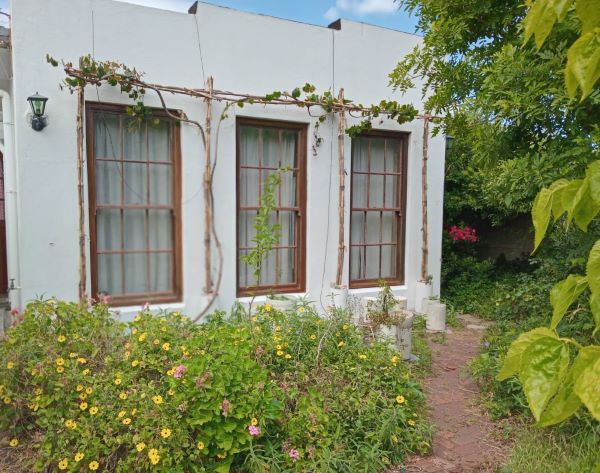
A bamboo trellis made to clear the windows of vine tangle.
Dear gardeners and nature lovers In this newsletter I hope I may give you news more personal than usual, because other things have kept me so busy that the gardening has taken a back seat. I must fulfil the goal of sending out a monthly letter, come what may. I apologize for having to delete the article on native seed collection attached to the last newsletter. It wasn't scientifically accurate on a few points, and if I'm taking this pursuit of knowledge about biodiversity to a higher level to provide a better service to readers, giving out accurate information is of vital importance. 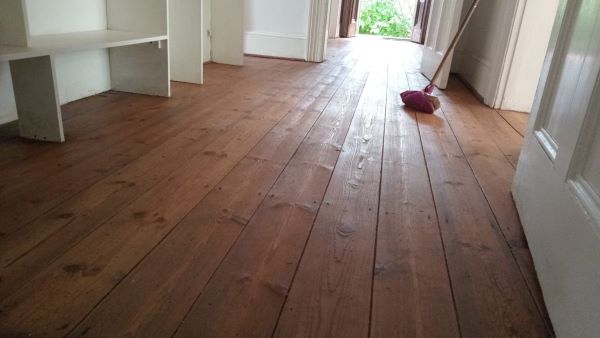
The passage after hand polishing with a hard brush, non woven polishing pads and a hollow fibre cloth. What a permaculture house renovation could look likeI come to you as a very tired human being, but I hope for things to look up soon as this chapter of my life comes to a close and another starts. I have just completed a massive project for the family, cleaning out and freshening up my mom's old house after she moved out and moved in with me. It is a clay brick Victorian cottage with wooden floors and window frames, lovely solid old doors and fixtures.In accordance with the theme of this newsletter I've taken on the challenge of making notes on how natural restorative principles could be applied to a renovation, and my experience in trying to do the right thing on this project. I'm using some permaculture principles as a guideline, but they feed off into many other fields, like circular economies, reduction of embodied carbon, conservation of native flora and more. 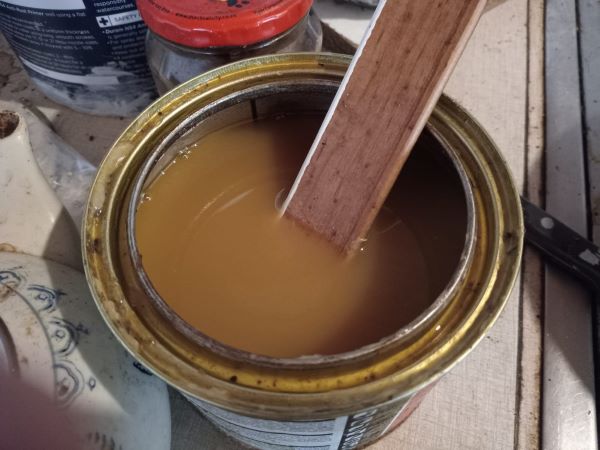
The floors needed a breathable protective coating. There was nothing suitable on the market. This was my special formula based on beeswax and oil.
My first lesson was that the pressure to make money out of the project, the constraints on time, lead to using products with a higher carbon footprint, of a more industrial nature than I would have liked. Very often the old ways require more skill, much more knowledge and more time, but not always. Finding out which traditional methods save time and which guzzle time is an important lesson. Often the products on the market are very different to what was used a few decades ago and are not necessarily improvements in terms of natural housing. It all has to be kept in the balance, and one day if I ever have my own project, I can go deep green, as I wasn't able to here. Permaculture principle "observe and interact"The house is our family home and has been for over 100 years. It was bought by my grandfather in the early 20th Century. There has been plenty of lived experience of the house, interactions, fixings, tweakings, and even alterations over the years. I tried to find out as much as possible about the work done by my grandfather, my father and my mother on the house and why they made the choices they did. I set out after considering what the house had to offer, just to clear out the stuff that filled the house to the brim after almost half a century of constant habitation, repair broken parts of the buildling, paint, and feed and protect the woodwork.
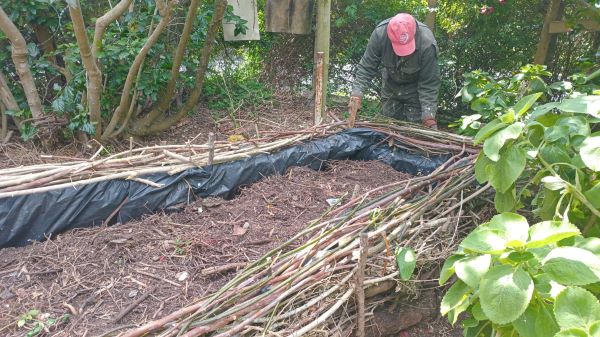
George skillfully 'disappeared' great piles of brush wood into Hugelbeet style raised beds contained by dead hedges. Catch and store energyI wanted to install solar and there is a nice flat roof that could take panels, but it isn't the right time. Funding is needed for that and perhaps strengthening of the roof first. The mature state of the garden and all the trees has brought a slow increase of fertility in the whole garden over the years. Everything grows 'like a bomb' even things I have tried and failed with repeatedly in my own regenerative garden on the Cape Flats' sandy soils in Goodwood.Obtain a yieldThe intention is to yield income for the family group to pay for care for two people who really need it, so this yield was my focus.Apply self regulation and accept feedbackThere have been quite a few instances of feedback on what I was doing and I've had to self regulate. To produce a yield sooner, all I could do was double down on the time I put in, and call in agents to advise me on what was absolutely necessary.
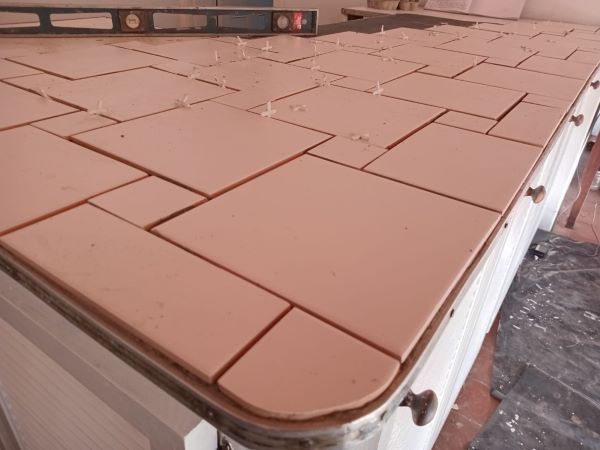
This is during the laying of pinwheel pattern tiles on the kitchen counter Use and value renewable resources and servicesI tried to decrease the carbon footprint of the renovation in every way feasible. This I did by not replacing carbon heavy items like tiling when possible, or using tiles I had already from another job that would have been thrown away as their resale value is low. Wood, paint, cement and other materials that were there already were used when possible for the renovation. This does not prevent a large amount of new materials being required.One should always remember that the materials needed for redoing bathrooms and kitchens have a very high embodied carbon count, as most of the materials from metal to tiles and cement are fired at very high temperatures. I didn't want to replace everything, only to have the next owner or the tenant wanting it all to be changed again. What a squandering that would have been. Personally I'm really allergic to 'new' and renovated bathrooms with their giant tiles as they just look so ugly and cheap to me, so I was glad to be able to avoid retiling. The simple white tiles my grandfather installed have not aged, cracked or fallen off in close on 100 years. Why fix what isn't broken, and requires such low maintenance ? They have a lovely black 'dado' rim on the white in typical early 20th Century style and I think this could be artfully incorporated by any tasteful decorator.
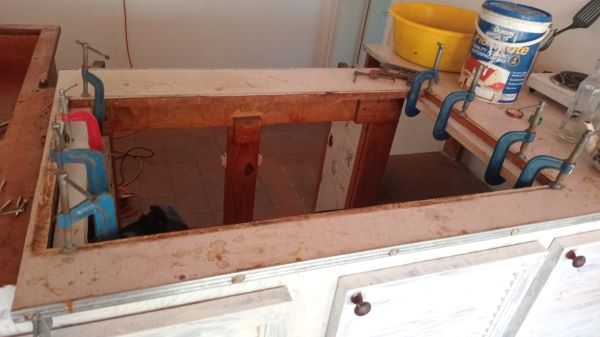
Before laying the kitchen tiles the hole where the hob used to be had to be patched sturdily. Produce no wasteWorking alone and carefully with materials I tried to reduce waste, but emptying the house of a hoarder is going to require quite a bit of dumping and much of that goes to landfills. One of my painfull lessons was that being careful about dumping was very counterproductive to our yield (money) and that I was wrong about reusing as many items as possible. This is because bitter experience has taught me that finding a home for everything is just so hard and would have made the job take a decade not two years. So 'no waste' principles had to be balanced against my life's time, time being our most precious resource, and the need for the financial yield.I donated the books and filing materials to our local library by the boxfull and many of the clothes went to the Salvation army. I threw away the piles of squashed old fashioned shoes found in the roof, but I think the municipal dump staff were interested in selling them so they may have been reused. I built a large composter and composted tons of old paper and other organic residue, cardboard boxes and fabric tubes, chewed items and squirrel poop from the roof, and lots of garden waste as paths are cleared through the beautiful jungle garden. Uncompostable and broken items found their way to the municipal dump and other scraps went into the frequently overflowing dustbin. I think taking masses of material to the dump is much better than putting them in the dustbin. At the refuse depots people make a living by sorting out re-cyclable and re-usable items, whereas the garbage truck crushes and mixes everything and dumps it at the land fill site. However, we do have many rag pickers who comb through the dustbins to retrieve anything of worth. The trouble is they don't have transport beyond old supermarket trolleys, and so they leave the low revenue items like paper. I wish they got more support for the work they do.
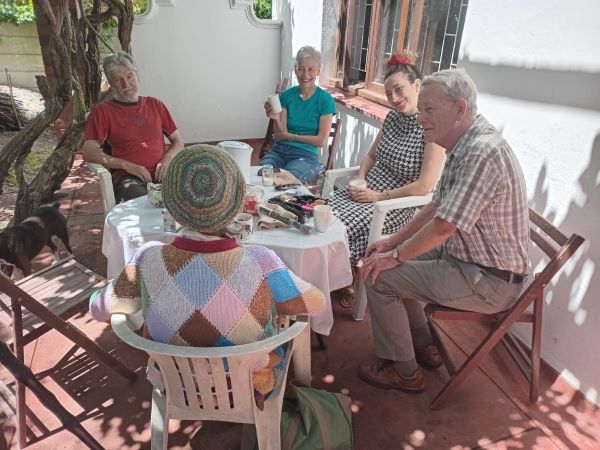
Mum centre, my husband, uncle and family in a memorable family get together on a nice clean stoep under the pergola. I took a lot of asbestos guttering, and some my mother had buried in the garden, rock wool from the dismantled stove, and dried up or unusable old paints, spray cans and a lot of mysterious solvents I couldn't identify to the hazardous waste depot near the old power station which is a lovely old building. It occasioned interactions with the staff there that lightened my mood and I always try to dispense happiness and attention to all people I have to deal with and never be grumpy, but I'm not perfect. It sweetens my life and I hope theirs as we grind through the necessary business of waste processing in the city. Old appliances and broken wheel barrows were removed and sold as scrap metal to my neighbour to be recycled by metal companies. It is the only set of items I've received a yield on thus far, small as it was, but I plan to be selling other house contents that I deemed more valuable as soon as the property is dealt with. 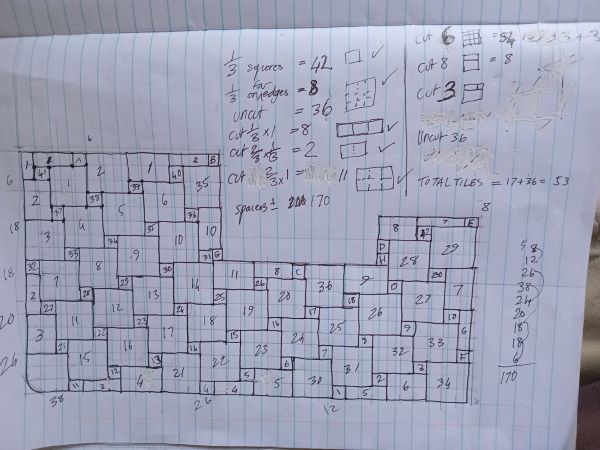
My third tile layout plan calculating the number of cuts needed. Design from patterns to detailsI prioritized fixing the house and there was no designing there, except a general principle. Sort and clear stuff and caring for surfaces to produce empty rooms, white walls and well cared for floors. Painting walls that had not been painted for thirty years or more required many coats of paint, up to four. The floors were very dirty, requiring stripping with hydroxides till clean, sometimes up to five times to get out grease stains and trodden in dirt. I then coated with my own polish and oil blend and I made 36 tests before finding the right formula. I made my own blend as the floors have lasted a century with regular waxing, but need to be sealed against getting dirty too quickly. There was nothing on the market for sealing floors that did not contain polyurethane. Coating floors with plastic in a house built of clay is asking for damp problems and mold down the line. This rather obvious deduction is substantiated by my extensive reading on old clay buildings.The emptiness was lovely and the new white walls and ceilings lifted the house completely, so that it is ageless and can accommodate modern or antique furniture with grace. I had to do many repairs from replacing broken gutters and windows, to fixing rotten doors in the garage, replacing a ceiling that had been ripped out and had its glass fibre stuffing hanging out, recovering a sink whose wooden top was disintegrating, pulling up a very smelly old urine stained carpet, putting in some fittings like wall hooks to prevent the Victorian glass doors from breaking in a gust of wind, hooks for the cords of blinds, struggling with walls that didintegrate into powder under the drill, creating a base for a sagging watertank that spilled rainwater onto the house walls, an accident when my hubby put his foot through the ceiling while cleaning in an area where there was none of the old wooden ceiling, making the corrugated iron roof at the back watertight and much much more. Some trees hanging over the roof had to be radically trimmed as their leaves form acidic compost if lying on the roof. Cutting the trees created a domino effect at one side of the house where the canopy was all grown together. Eventually we had taken away so much that a long winding horizontal branch blew down in the wind and broke the fence. This is the nature of such a project, it is like peeling an onion. Fixing sometimes creates further work. It is not the only instance. The gutters were another example. I wanted to give up so many times, but I didn't. 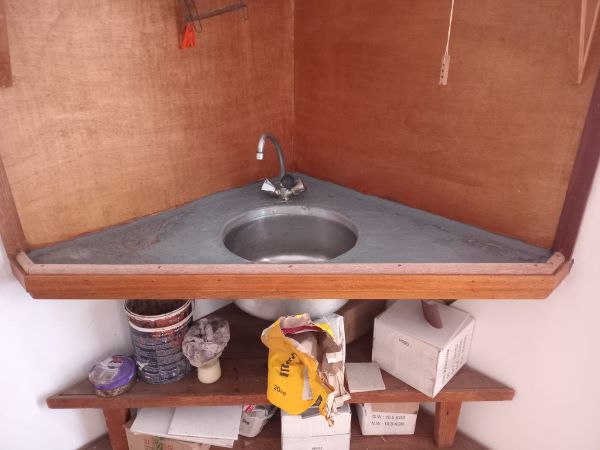
The exfoliating corner basin built for me by my dad with a new waterproof cement surface. Later coated with a waterproof red oxide finish and concrete sealer. Beyond fixing the basic broken stuff the house was just emptied, cleaned, painted and oiled and otherwise left alone, except the kitchen. A large broken hob and oven had to be dismantled and removed as they were too big for the car. This took longer than expected, as do most jobs, and this was just part of the general frustrations that required enormous patience and perseverence. Moving in small steps and never stopping, permaculture style, really did get me through this marathon. The counter was patched and then tiled with white tiles on the agent's recommendation. I had a tile surplus from the ensuite bathroom I built for my mother. Tile sellers' insistence on selling by the box is another environmental bug that I'll not dig into now. The predominant white was carried over the very grubby 1970's pine cupboards which just wouldn't come clean. The kitchen is open plan and in a dark corner and whitening all surfaces has made it much easier to work there now. All this had to be done before I could start on the garden. A while back we took down trees overhanging the roof and some of the exotic ten meter hedge to let light into the garden, and pollarded a huge exotic, fungus ridden giant Persian lilac which was pushing the indigenous forest trees, a Podocarpus, Cape chestnut and lovely witstinkhout or Celtis africana, to one side. There was a lot of cut wood and in another life I would not do the permaculture thing and keep it on the property, but pay to have it removed. Carbon is recycled on the property as much as is possible time wise, with compost and biochar and dead hedges. Processing the wood was at least twice as expensive as removal, but we fitted it in when my mom's gardener had no painting to do in the house. He applied his traditional skills to creating some dead hedges and they are beautiful indeed and I recommend them to anyone who has a 'problem' with a lot of branches which need recycling. They don't need to be cut up as much as in preparing for firewood, one small clipper being enough to clean them sufficiently. 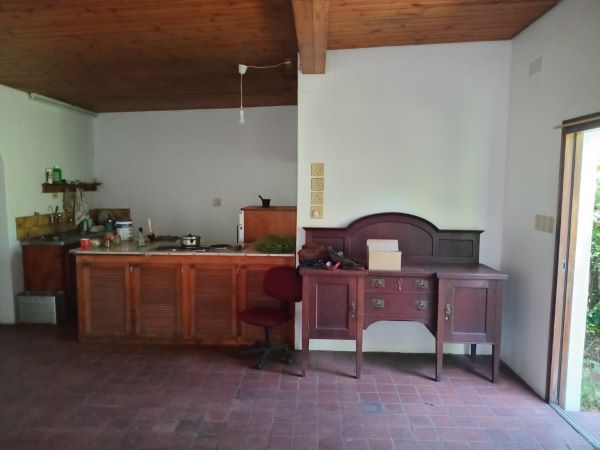
The old kitchen cupboards before painting made the kitchen very dark. I've only been doing the garden down on the ground for a week now. The pattern being maintenance and trimming. My mother's well established forest garden of large native trees was left totally intact unless a tree was hanging over the tin roof. Most visitors love it. Small 'broadly' indigenous mixed lawns have been created in two flat empty areas. The gardener has pulled out a mountain of the invasive balloon vine, Cardiospermum grandiflorum from trees, hedges and other vines. I've done lots of cleaning up of the outside sitting areas where one can have meals under the pergolas and clearing of paths and sweeping up leaves that cover the brick walk ways. Repair on some paths and drive way is needed to make them trip proof. I've started a nutrient and carbon cycle, producing compost that the next user/owner may or may not want. It had to be done just to be able to clean up. I'm still going to, God willing, stake the olive tree and translocate more grass from where it is not desired to where it would be useful, and just neaten and trim every day in the early morning and late afternoon when its cool. I've heard my grandmother kept hydrangeas in tents made of sacking to protect them from the sun. They required a lot of watering. The garden is much changed and has a totally different very water retentive ecosystem now, with a closed forest canopy over quite a large space. Cool breezes from the mini forest waft down the passage and into the front bedroom. Its super comfortable and lovely. 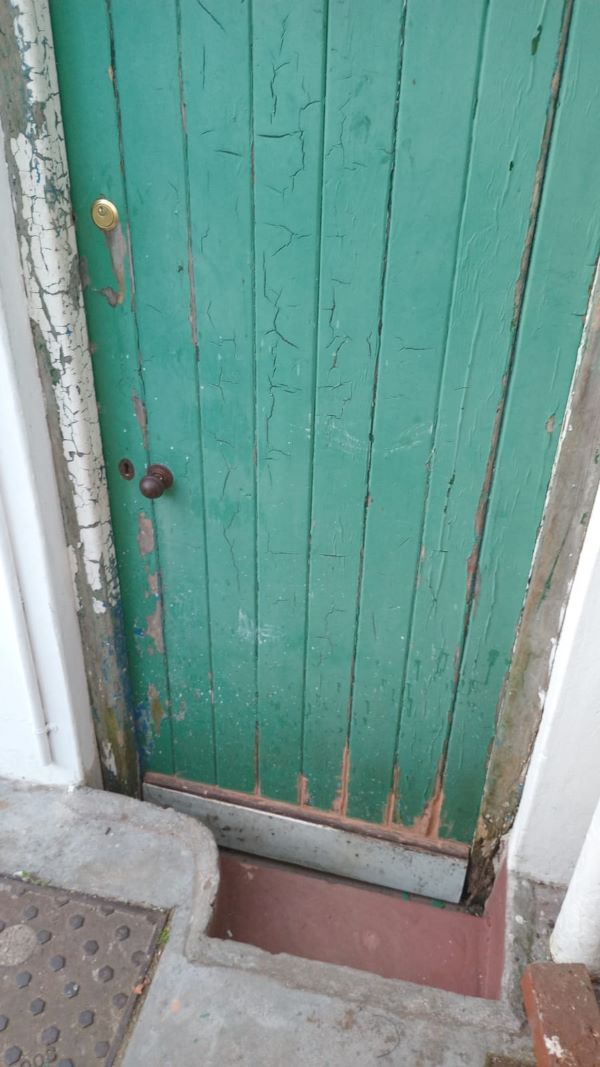
Repaired garage door before it got painted with terra cotta enamel to harmonize with its surroundings. Integrate rather than segregateI hope to have done as much integration as possible, except for finishing the house first. If future inhabitants wanted, they could plant Peninsula Shale Renosterveld plants as that would be our natural potential vegetation. Only one house away and the soil is for Cape Flats Sand Fynbos which would have covered most of the flat land all the way from here to Stellenbosch, about 40 kilometers. We are probably on an ecotone, or transition zone. There could be interesting and certainly diverse possibilities if replanting. Native plantings would integrate the garden into the larger biosphere and the re-nativizing projects in the area, like Keurboom park.
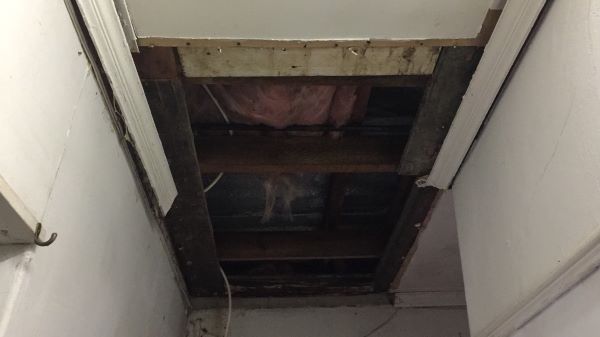
The passage ceiling had been torn out. Finding matching cornice profiles was impossible so much patching together was needed. Use small and slow solutionsMy solutions were very small, especially after the repair budget ran out. They were based on minimal interference, just cleaning, clearing, painting, polishing and fixing broken things rather than replacing with new ones. Replacement would have required a lot of smashing and rebuilding and a huge materials budget. There were so many broken things, windows, drains, ceilings, roof, and a lot of snarl ups.By snarlups I mean the kind of solutions that a very very old eccentric person with, at the kindest, a creative approach to building would attempt. This usually consisted of tying up the problem with wire and coloured string, and lots of little pieces of shade net or plastic sheeting. So I spent much time stripping away the snarl ups and fixing things properly from scratch. So many skills with so many different kinds of materials had to be learned. My Dad who was gifted in handwork to say the least, said that the house involved too much upkeep and wanted badly to be rid of it, and this was two decades ago. Since he died no proper fixing was done, no painting was done, but burglar alarms and trelli bars were installed everywhere, for which we can be grateful. 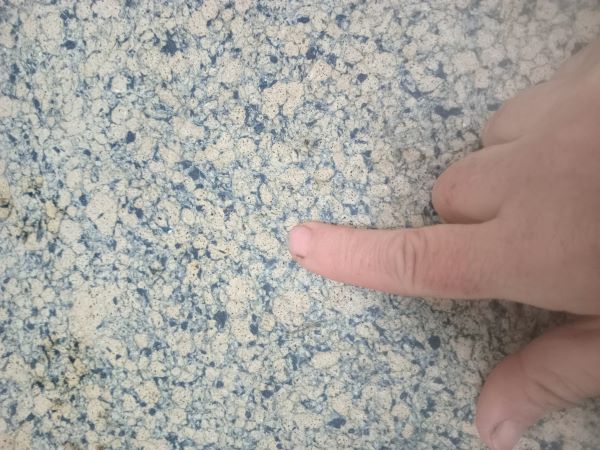 Some of the materials in the house could not be identified with any certainty such as the possible Venetian plaster floors in the bathrooms and back passage.
Some of the materials in the house could not be identified with any certainty such as the possible Venetian plaster floors in the bathrooms and back passage.
Its small pits first led to an ID as salt etched cement, but a few experiments in a concealed corner showed by chemical reaction that it was calcium based. After much research in which answers were very hard to find I concluded that it is Venetian plaster. It has been used on floors but this is much rarer than the wall treatment. It is so unusual a finish that I cannot find another in Cape Town, or anyone in this city to advise me as to how to clean and seal it. I've seen examples from around the world and they are generally broader and messier in appearance so the craftsmanship on this floor was exceptional. I can only think it was made by Italian prisoners or refugees during or after the second world war as the exclusive knowledge of this building method is in the hands of Italians and Russians to this day. I decided to leave it alone even though it is damaged in some areas. A future inhabitant can make the choice to destroy or keep it. 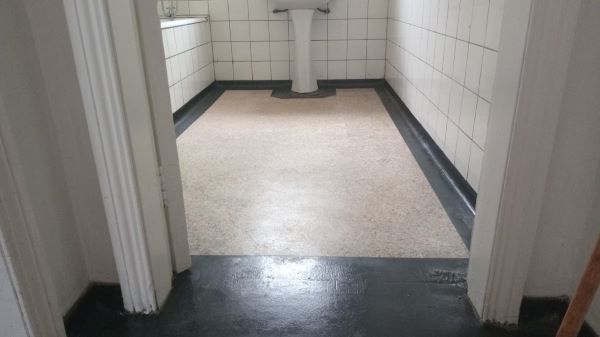
The Venetian plaster floor in the bathroom after coating with beeswax polish and buffing three times. Use and value diversityWhen planting a small lawn I did plant mixed grasses, two native and one African, as they all support butterfly larvae.If I were to stay longer as the gardener, I would work on introducing plants from the potential natural vegetation, which is Peninsula Shale Renosterveld. There is nothing left of course and its place has been taken by exotic garden plants, oaks, jacarandas, and so forth. The grasshoppers and chameleons in the hedge I remember from my childhood are long gone. If one is planting a biodiversity garden, this is one of the best articles I've seen thus far. It is a very detailed account of the complexity of insect decline in Germany, and what to do about it, that could be useful to anyone in the world. https://www.youtube.com/watch?v=9iPINmQpdDI Use edges and value the marginalThe hedge surrounding the property is a wonderful opportunity to leverage edges. Special plant choice and techniques would have to be used to plant into the root zone of the established large exotic Meterosideros trees that constitute the existing hedge. A wild olive and hibiscus manage to compete with the Meterosideros roots, so those may be clues as to what would survive. I've raised some pomegranate, kei apple, wild asparagus and Harpephyllum which could be mixed in with the existing hedge but they may not persist. All of these are food plants, but only the wild asparagus is locally indigenous. It is loved by insects when it flowers. Other edges are the border between the forest garden and the sunlit part, lawn and beds, and many areas with well lit but shaded house walls on the side away from the equator, for us the south. Common to most urban gardens, we too have a lot of wall space with different light conditions that could be used for growing.
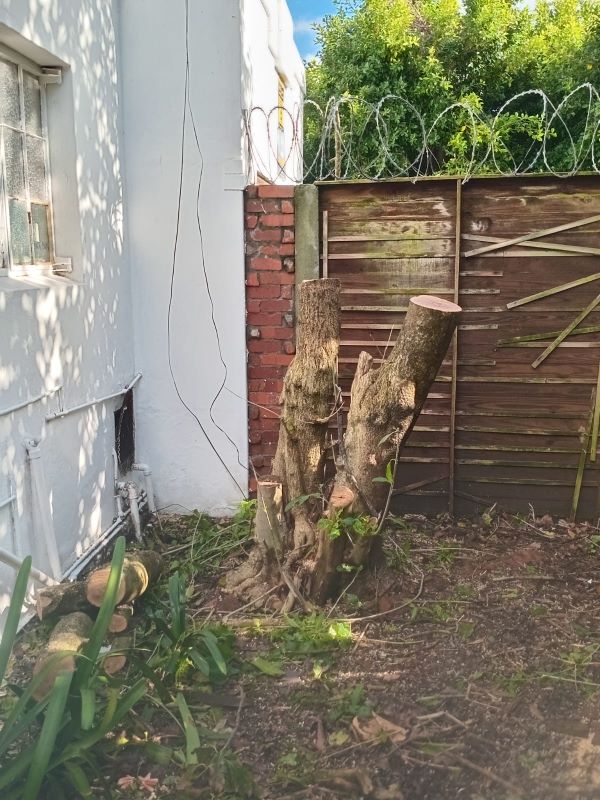
The remains of a tree that was overhanging the roof. It has resprouted again quickly and is a giant green pompom now. Creatively use and respond to changeWe had many plans for the house, but when the budget ran out I had to rethink everything. Replanning was ongoing. I find that creative solutions come if you let a problem sit for a night or two, rather than rushing into the first solution that comes to mind. This is the way I tied up many loose ends and found dual or new purposes for materials and could save a lot of money.In the garden vegetables came up on the edge of the lawn, an edible solanum, amaranth and squash plant and we left them, deeming them at least as attractive as the lawn. We removed a lot of the ubiquitous and invasive scurvy weed or Commelina livingstonei. It is apparently edible but I find it too fibrous to be palatable. Where there is nothing to take its place it can stay in place. This will shade the earth and protect the garden's amazing fertility. I do hate bare soil baking in the sun. A lot of trees had to be cut back and this means there is a lot more sun and the Clivia nobilis are suffering and will need to be moved and what better place than the dusty bare spots in the shadows on the south side of the house where the sun only reaches in high summer but they have plenty of exposure to indirect light from the sky. It remains to be seen if this will work and I probably will not witness their flourishing. 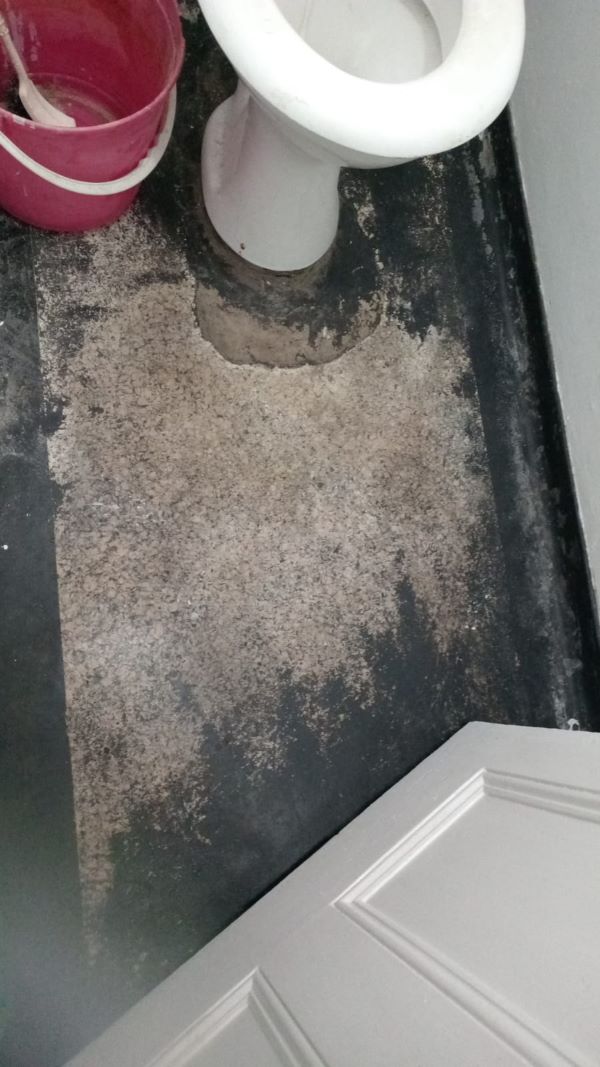
The first of numerous sessions removing the black enamel paint from the toilet floor with stripper. In conclusionTIMEThis project has taken two years and a lot of my time, and made writing and persuing other interests very difficult. My garden has suffered the most perhaps, and looks so terrible I'd be ashamed to share pictures. I guess its my service to community. Community being my family and the two people who will need money in the next few years to cope with the illness.It puzzles the family and everyone who hears about it, that it took so long. I think you sometimes don't know what you have bitten off until you begin chewing. I was in the ring and taking the blows and its not surprising to me. Volatile markets have required a change of strategy from renting to selling and this means a lot of time wasted, if seen in retrospect. One tends to assume that time is money, but it is not always. The time I've invested is practically valueless on the property market. The money we have lost due to me, and the house being tied up so long is not. SKILLSThe job taught me so much about the high maintenance needed on historic homes. Due to budget constraints I did a lot of the work myself, and had to learn many new skills and made a lot of mistakes, and learned of my limitations. As I realized about half way through that everything always took longer than I and everyone else expected I read several books on project management and learned a couple of things about task sequencing so that the longest chain of dependent tasks never gets derailed.Sometimes I wonder what this project has taught me. I think it is to be terribly patient, and that we sometimes have to carry on when a thing seems pointless, because there is no alternative. This is an almost biblical skill, there being many instances in the bible of seemingly excessuve endurance. Faith may be the only relief for this all too human form of suffering.
TOOLSWorking in one part of town at a great distance from one's home requires either a truck where the tools are kept, or two complete sets of tools. No matter how well I planned and I planned with great focus almost daily, way too frequently the tools I needed were in the other part of town. It may be my 65 year old brain or my ADHD and poor organizational skills but I worked so hard against these and it was still a major drag on proceedings. Inevitably the tools had been recalled for work on my own house. As a consequence I avoided doing any work on my own house and it got terribly neglected. Knowing what I know now I would probably have invested in a second set of tools. However when you are trying deparately to get rid of excess stuff accumulated by parents who bought everything except tools in triplicate, and never threw away anything, the last thing you're going to feel like doing is duplicate your tool set and acquire more stuff you have to clear out later.PERMACULTURE PRINCIPLESUnfortunately there is a high cost to permaculture practice when renovating a home. Recycling and handwork, traditional materials and recipes are very time consuming and require more skill to apply. I don't think its a very good idea when the project is for other people and they do not want the same things and have very different needs.
Topic suggestions welcomeYou may write to me anytime at the website greenidiom by filling out a comment. You can also use my webmail (website mail) address greenidi@greenidiom.com. Have you missed anything ?Please go to back issues right below if you want to catch up with what I've sent thus far as preamble for the course, as well as previous newsletters. |
| Back to Back Issues Page |